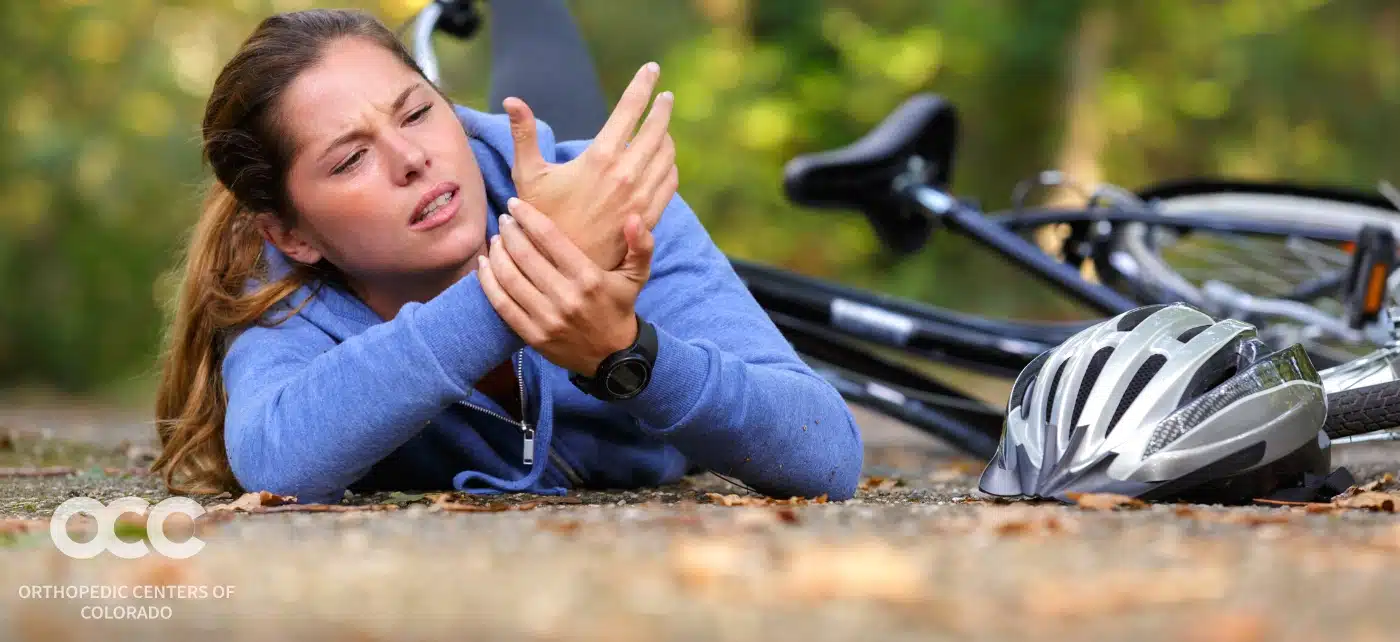Scaphoid wrist fractures are usually difficult to identify. The scaphoid is relatively smaller than other bones of the hand, so the fracture may not be visible. The scaphoid area may not seem swollen, and one won’t always feel severe pain. As a result, people often ignore a scaphoid fracture, confuse it with a sprained wrist and attempt to self-treat at home. However, left untreated, it may take six months to heal. The medical experts at Advanced Orthopedics & Sports Medicine Specialists in Denver, Parker, or Aurora, Colorado, are skilled at correctly identifying and treating a scaphoid wrist fracture, ensuring you won’t end up with complications that could have a negative impact on your everyday life.
OVERVIEW
Scaphoid wrist fractures, like all bone fractures, can affect anyone. This type of fracture occurs most often after a fall onto an outstretched hand or other accidents. Scaphoid wrist fractures account for 2% to 7% of all fractures and 60% to 70% of carpal bone fractures. They are often found in teens and young adults under 30. People with osteoporosis have an increased risk for all types of broken bones, including scaphoid fractures.
ABOUT THE SCAPHOID
The scaphoid is one of eight carpal bones which form the wrist. It is located on the radial side of the wrist under the thumb. The name “scaphoid” is derived from Greek and means bowl or boat, which is an apt description of its shape. The scaphoid bone can be found by holding the thumb up while looking at the back of the hand. The triangular indentation that’s formed by the tendons of the thumb is called the “anatomic snuffbox.” The scaphoid is located at the bottom of this triangle. The scaphoid is a delicate bone with a precarious blood flow. If that blood supply is cut off, the bone will not receive the nourishment it needs to repair itself.
WHAT IS A SCAPHOID WRIST FRACTURE?
Quite simply, scaphoid fractures are a type of broken wrist. The scaphoid has three parts, all three of which can be broken. Sections of the scaphoid include:
- Distal pole: the end closest to the forearm
- Waist: the curved middle of the bone that lies under the anatomic snuffbox
- Proximal pole: the end closest to the thumb
About 80% of scaphoid wrist fractures happen at the waist, 20% at the proximal pole, and 10% at the distal pole. The site of the fracture affects how it will heal. Fractures in the distal pole and waist usually heal quickly because they have a good blood supply. Scaphoid fractures are divided into two types depending on their severity: displaced or non-displaced. A non-displaced fracture refers to the condition where the bone pieces or fragments stay in their correct position. A displaced fracture refers to a situation where bone fragments move from their original lineup. Scaphoid fractures that do not heal are referred to as scaphoid non-unions. Ultimately these can lead to loss of wrist motion and even wrist arthritis.
CAUSES
Common causes of scaphoid wrist fractures include sports injuries, car accidents, and a condition called “FOOSH”. FOOSH stands for “fall onto an outstretched hand.” When someone senses they are about to fall, they instinctively react by cocking the wrist and extending the arm to try to break the fall with the hand. This protects the face, head, and back from injury, but it means the wrist and arm take the full force of the impact. When it causes the wrist to bend back farther than it’s meant to go, a fracture may occur. The angle of the wrist when it hits the ground affects where a fracture happens. The farther the wrist is bent back, the more likely it is that the scaphoid bone will break. FOOSH injuries occur in many sports, such as skiing, skating, snowboarding, or gymnastics.
SYMPTOMS
Common symptoms:
- Pain
- Swelling
- Tenderness
- Inability to move the wrist
- Bruising or discoloration
- Unstable thumb or wrist movement
- A deformity or bump not usually on the wrist
- The hallmark symptom of a scaphoid wrist fracture is known as “snuffbox” tenderness located by making a thumbs-up sign.
NON-SURGICAL TREATMENTS
How a scaphoid fracture is treated depends on the severity of the original break and the alignment of the fractured bones. If the scaphoid fracture maintains proper alignment, the wrist, and thumb are immobilized in a short arm/thumb spica cast until the fracture is healed. Some surgeons may treat this in a cast above the elbow followed by a short cast. If, however, after six weeks of casting, the fracture is not healing properly, a bone stimulator may be used. This device used electromagnetic energy to coax new bone growth.
WHEN IS SURGERY INDICATED?
Surgical treatment is indicated for non-displaced fractures which have not healed after six weeks of splinting or casting. It is also necessary for unstable scaphoid fractures and displaced scaphoid fractures. Screws are most often used to realign the scaphoid fragments via open reduction and internal fixation. If the union of the bone is not achieved with surgery, bone grafting may be needed to heal the fracture. After surgery, a cast will be used for eight to twelve weeks. The cast is removed once an X-ray shows the fracture is healed. Frequently surgery is done to speed up the healing time with elite athletes allowing them to return to play quicker.
GETTING THE RIGHT DIAGNOSIS. GETTING THE RIGHT DOCTOR.
Scaphoid wrist fractures aren’t easily diagnosed. X-rays are usually the primary diagnostic tool, but up to 25% of scaphoid fractures aren’t seen on an X-ray right after the injury. It may take up to two weeks to show up on plain films, especially if the fracture is displaced. So even if you have X-rays taken at an emergency room right after the injury, to get the help you really need and to avoid complications, you need to meet with orthopedic specialists who have had extensive experience in treating scaphoid wrist fractures, like those at Advanced Orthopedics & Sports Medicine Specialists in Denver, Parker, or Aurora, Colorado. After a thorough physical exam, they may need to follow up with other imaging like CT scans or MRIs to arrive at the proper diagnosis. The outcome is usually very good if you see them right away so that you can regain the mobility and strength you had in your wrist before the injury occurred. Book an appointment now.










